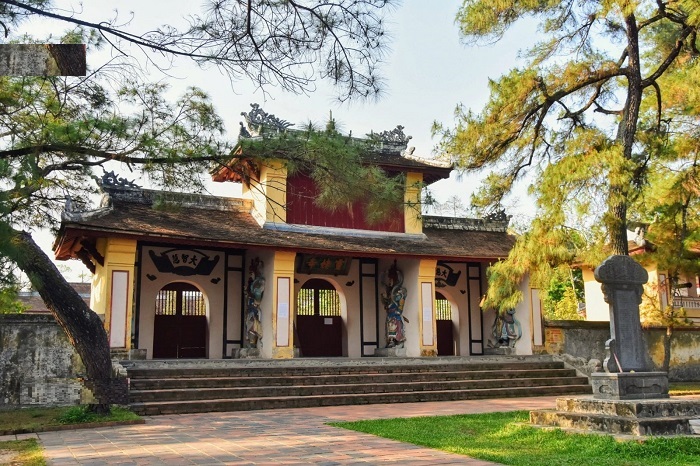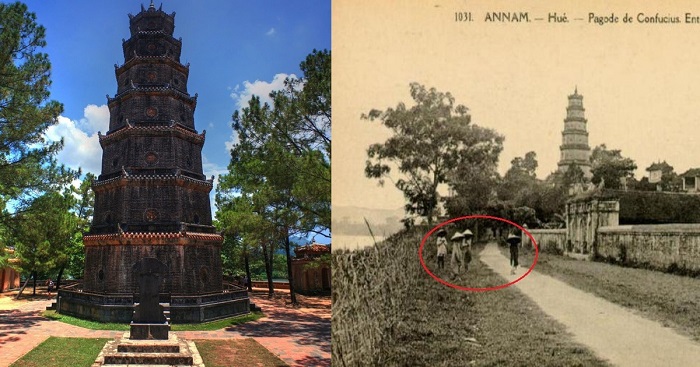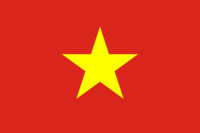Thien Mu Pagoda in Hue – Exploring the 400-Year-Old Sacred Pagoda
Thien Mu Pagoda in Hue hides numerous historical stories waiting to be explored. Take away the following information to enhance your journey!
When traveling to Hue, visitors can experience the soul and essence of the national culture. Among these cultural treasures, Thien Mu Pagoda in Hue is often referred to as the “soul” of this ancient land. Thien Mu Pagoda is an unmissable check-in point when visiting this former imperial city. Let’s explore the fascinating and interesting aspects of this sacred 400-year-old pagoda!

1. Introduction to Thien Mu Pagoda – Hue
- Location: Thien Mu Pagoda, also known as Linh Mu Pagoda, is situated on Hau Khe Hill in Kim Long Ward, Hue City, Thua Thien Hue Province. The pagoda is located on the northern bank of the Perfume River, approximately 5 km west of the city center. This location offers picturesque scenery and becomes an indispensable stop for travelers when visiting the ancient capital.
According to historical records, Lord Nguyen Hoang, the first ruler of the Nguyen Lords in the southern region of Vietnam (Dang Trong), was responsible for constructing this pagoda. In 1601, as part of his efforts to develop the region and establish his reign, Lord Nguyen Hoang and his troops roamed along both banks of the Perfume River. Suddenly, he spotted a small hill rising by the azure river, resembling a dragon turning its head.
At the same time, locals in the area were sharing stories about an elderly lady dressed in red with a kind face. Every night, she would ascend Hau Khe Hill and tell the people that a lord would build a pagoda here to safeguard the realm. Seeing his vision aligned with the recounted stories, Nguyen Hoang immediately ordered his soldiers to construct the pagoda on the hill. At that time, the pagoda was named “Thien Mu Tu” or “Heavenly Lady Pagoda.”
Throughout the years, the pagoda has undergone several renovations. The most significant one took place in 1710, during the reign of Lord Nguyen Phuc Chu. He made substantial changes and improvements to Thien Mu Pagoda. Notably, a 2-ton bronze bell was cast and placed in the Dai Hong Chung Pavilion.
Until today, the pagoda rightfully holds the title of “First Ancient Pagoda,” signifying its significance as not only a place of spiritual worship but also a beautiful landmark in the former imperial city. Besides exploring the attractions in Hue, choosing accommodation for relaxation and recharging energy after each journey is also important.
2. How to Get to Thien Mu Pagoda in Hue
2.1. Directions to Thien Mu Pagoda To witness the iconic image of Thien Mu Pagoda towering by the Perfume River, starting from Hue’s Imperial City, you can go through Dang Thai Than Street, then turn left onto Yen Kieu Street. Continue a bit further, turning left onto Le Duan Street, and proceed until you reach Kim Long Street. Afterward, it’s just a 2 km journey to your destination.
2.2. Transportation to Thien Mu Pagoda
Hue’s tourism infrastructure is well-developed, offering various transportation options for visitors:
- Motorcycles: Hue’s tourist attractions are not too far apart. Traveling by motorcycle allows you more flexibility in choosing your destinations and time. You can rent a motorcycle for a day at your hotel, with rental prices ranging from 80,000 to 150,000 VND per day.
- Taxi: Thien Mu Pagoda is only 5 km from the city center, so taking a taxi is a convenient and cost-effective option, saving you time. Before hiring a taxi, it’s advisable to check the taxi service rates in Hue to avoid overcharging.
- Private car: You can explore the city by a private car with English speaking driver
3. Opening Hours and Admission Fees for Thien Mu Pagoda in Hue
- Opening Hours: All day
- Admission Fee: Free
If you’re planning your budget for your trip and wondering about the admission fee for Thien Mu Pagoda, you’ll be pleased to know that the pagoda is open to visitors free of charge every day of the week. This allows tourists, worshippers, and sightseers to access and appreciate the pagoda’s beauty and serenity.
4. What to Explore at Thien Mu Pagoda in Hue?
4.1. Scenic Beauty and Tranquility Thien Mu Pagoda in Hue is nestled on the banks of the picturesque Perfume River, exuding a peaceful and serene atmosphere. Even from a distance, you can admire the pagoda’s appearance, resembling a giant turtle carrying the ancient tower on its back. The pagoda stands tall, overlooking the Perfume River with grace and charm. The surroundings are adorned with delicate trees, ornamental plants, and serene lotus ponds. The scent of lotus flowers fills the air, creating an ethereal ambiance. Leaving behind the hustle and bustle of the outside world, here you’ll only hear the slow footsteps, the gentle rustle of leaves, the occasional ringing of bells, and the sound of wooden fish instruments from the main hall—a space that exudes solemnity and tranquility.
Dai Hung Palace Situated right within Thien Mu Pagoda, the Dai Hung Palace is where Buddha Amitabha is worshipped—a deity symbolizing boundless joy. The statue of Buddha Amitabha depicts a gentle and benevolent figure with large, attentive ears, a rotund belly symbolizing tolerance, and a warm, welcoming smile. The palace is constructed entirely of solid cement, painted to resemble wood, creating a familiar and comforting atmosphere. Apart from enshrining Buddha Amitabha, the Dai Hung Palace also houses a large self-portrait dating back to 1974 and an exquisite bronze bell. Inside the palace, you’ll find the altar, with the Trikaya Buddha in the center, while on the left is Van Phu Bodhisattva, and on the right is Pho Hien. Notably, the area behind the Dai Hung Palace serves as the final resting place of Venerable Thich Don Hau, the former abbot of the pagoda.
Phuoc Duyen Tower Phuoc Duyen Tower is an unmissable attraction when visiting Thien Mu Pagoda. This structure is located right after the entrance gate. Although it is positioned in front, Phuoc Duyen Tower is often seen as the “soul” of the pagoda. Its architectural design, along with other structures, forms a harmonious and distinctive complex that combines unique elements while still retaining the essence of Hue’s culture.

Phuoc Duyen Tower was built in 1844 under the reign of Emperor Thieu Tri. Originally, it was named Tu Nhan Tower but was later renamed to Phuoc Duyen Tower. During its construction, various materials, including clay, blue stone, and Bat Trang ceramics, had to be transported to the site from outside the pagoda.
The tower’s height is 21 meters, and it consists of seven levels. The tower is not only an architectural wonder but also an integral element of Hue’s cultural and spiritual heritage. Each level of the tower has its own altar. At the top of the tower, there is a statue of Buddha Amitabha cast in bronze. This statue faces the Perfume River, offering blessings and protection to the locals.
See more: Hue imperial city

